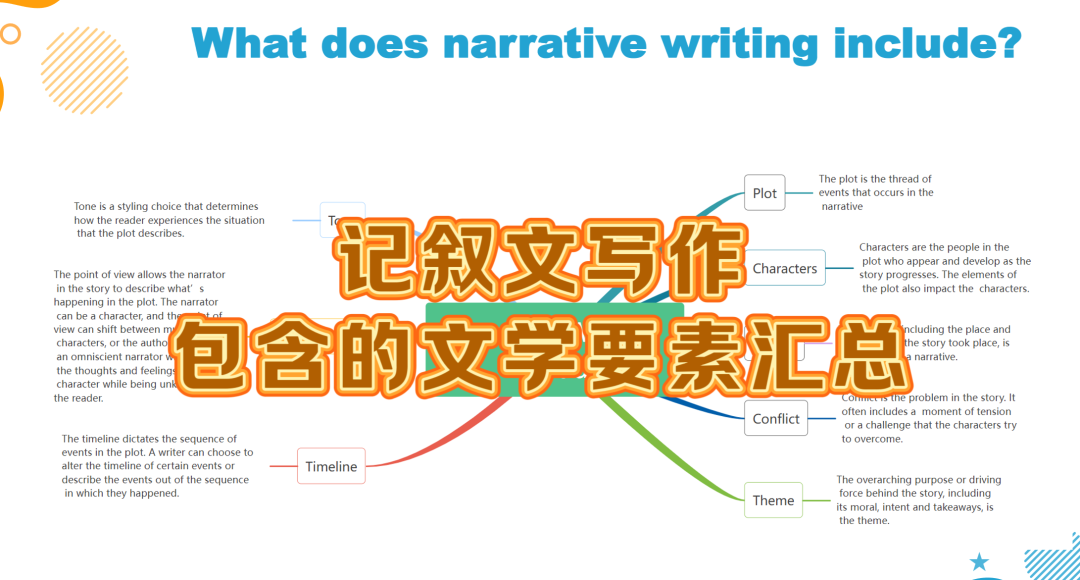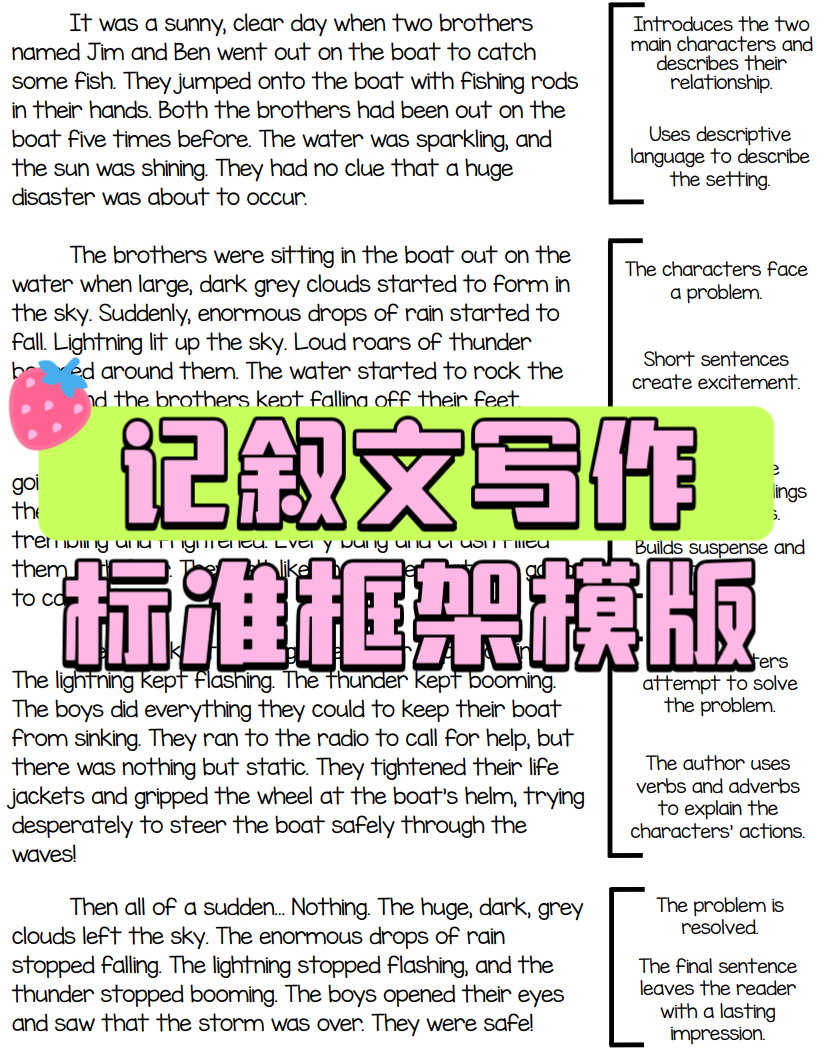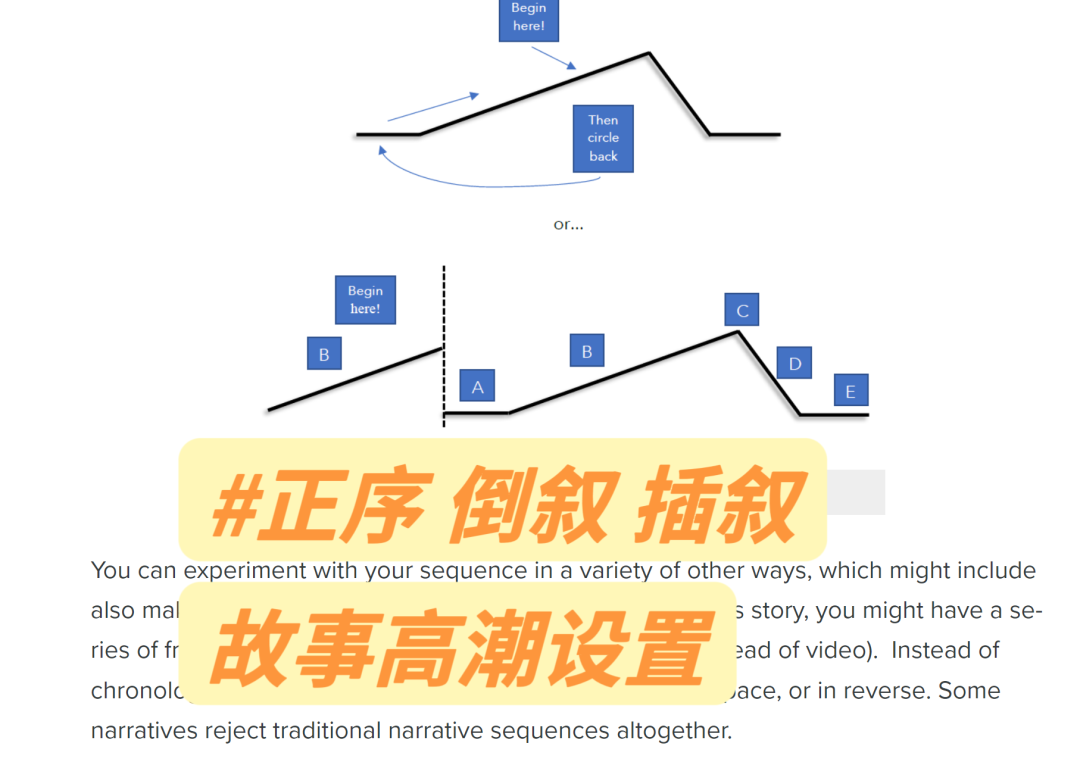你家的孩子寫(xie) 英文作文的時候是這樣的嗎?
➡️文體(ti) 特點記不住,不知如何應用;
➡️寫(xie) 完後為(wei) 何總是不確定,擔心小錯誤;
➡️作文想半天,都憋不出一句話;
➡️有證明觀點,但找不到合適的實例和引用方式;
➡️文章總感覺句式單一,缺乏深度......
國際小學的學生由於(yu) 年齡較小,加上英文閱讀和語言輸出水平參差不齊,在寫(xie) 作中常常會(hui) 遇到以上這些問題,怎麽(me) 破?
英文能力是國際學校學習(xi) 的必備技能!在課堂知識、考試評估中,優(you) 秀的英文寫(xie) 作能力是學生獲得高分的重要保證,也為(wei) 高年級的學習(xi) 打下堅實的基礎。那麽(me) ,在國際學校的低年級階段的英文寫(xie) 作,孩子們(men) 都學什麽(me) ?寫(xie) 什麽(me) ?怎麽(me) 才能提高英文寫(xie) 作能力呢?
國際學校的低年級學術寫(xie) 作常見的主要有三種文體(ti) :Narrative writing (記敘文) 、Opinion writing (議論文)和 Informative writing (說明文)。
國際學校【G1-G6】必考文體(ti)
說明文:實驗報告,科學雜誌等
記敘文:小說,傳(chuan) 記等
議論文:辯論,倡議書(shu) ,廣告等
還有不同寫(xie) 作文本:詩歌、郵件/信件、博客。
這也是將來同學們(men) 大考必備文體(ti) ,用IG英文大考舉(ju) 例,以下是劍橋官網對G10學生的大考文體(ti) 要求。


今天SS老師就來跟大家分享國際小學學生必備的三大文體(ti) 是什麽(me) ,文章的寫(xie) 作結構和要點,寫(xie) 出高分作文有哪些技巧。
01、Narrative writing (記敘文)
記敘文寫(xie) 作是國際學校的入學考試常見的文體(ti) ,尤其是記敘文中的創意寫(xie) 作,MAP考試大部分閱讀理解、以及高年級閱讀的文學作品大部分都是記敘文。
1、記敘文寫(xie) 作要點有哪些
記敘文六要素:
- 什麽人
- 什麽時候、什麽地點
- 發生了怎樣的事件
- 起因
- 經過
- 結果
寫(xie) 作時應選擇一件或幾件較有代表性的事例來寫(xie) 。重點部分要詳寫(xie) ,寫(xie) 具體(ti) 。在敘述事件之後,應進行必要的抒情,點明自己對事件的看法和感想,以此來深化中心,揭示主題。


記敘文的故事情節是最重要的部分,故事高潮如何設置呢?
故事高潮三要點
1️⃣緊湊:有序,能夠吸引讀者的注意力;
2️⃣懸念:有足夠的吸引力和懸念,引起讀者的興(xing) 趣和好奇心,讓讀者願意持續閱讀下去;情節有深度和內(nei) 涵,能探討人物的情感、價(jia) 值觀和社會(hui) 問題等,讓讀者在閱讀中獲得思考和啟示;邏輯縝密,即有連貫性:使讀者理解和接受故事的發展和結局;
3️⃣有爆發點,即高潮:引起讀者的強烈情感反應。

例文——Example: The Climax in
Harry Potter and the Sorcerer’s Stone
哈利波特與(yu) 魔法石
✅What is the climax:故事高潮
Harry Potter and Professor Quirrell/Voldemort’s shadow self have a major showdown in the forbidden third-floor corridor, ending with Harry saving the Philosopher’s Stone from Voldemort, hindering his plans to return to power.
In the climax, Harry realizes that Voldemort, whom we previously thought was dead, in fact survived the spell that rebounded on him and has been gathering strength through Quirrell’s help.
✅When does the climax occur:
高潮引發的後續情節
Third to last scene.
✅What value is the climax testing:
故事高潮引人深思-生命與(yu) 死亡 教育與(yu) 無知
Life vs. death. As an adventure story,Harry Pottermoves between the value of life and its negation, death. In the climax it is this value that is tested, as Harry is outmatched by both Professor Quirrell and Voldemort’s shadow and very nearly dies.
There is also a secondary, internal value: education vs. naiveté, as Harry has to apply everything he’s learned at Hogwarts to survive in this one unforgettable climax.
✅Outcome of the climax:故事高潮導致的結果
Harry faints, surviving the encounter only because Professor Dumbledore arrives just in time. This proves both Harry’s courage and also that he is not yet a match for Voldemort.
✅Subplot climax:故事的次高潮
Harry Potter and the Sorcerer's Stonehas a performance subplot with the value scale of accomplishment vs. failure. The scenes that follow the climax, which are part of the denouement, are actually the climaxes of the subplot, ending with the announcement of the House Cup-winning house.
機構課堂故事高潮分析-作業(ye)


02、Opinionwriting(議論文)
Opinion writing議論文是一種常見的寫(xie) 作文體(ti) ,議論文三要素包括論點、論據、論證。要求作者針對某個(ge) 特定主題或問題表達個(ge) 人觀點,並通過論證、舉(ju) 例或引用權威信息等方式來支持自己的立場。在議論文中,作者通常會(hui) 先提出一個(ge) 明確的觀點或論點,然後通過分析、解釋和論證來展示為(wei) 什麽(me) 這個(ge) 觀點是正確的或合理的。
議論文的難點
低年級議論文的難點主要是論據,論據的類型包括事實論據/理論論據。
1.事實論據:
①必須具有典型性。
②最好具有新穎性。
③論據的表述要準確、敘述要概括,能證明點。
2.道理論據:
①名言、警句、俗話、諺語、定理、公式等。
②精確,不能篡改、歪曲。
③和論點有必然聯係,能證明論點。
低年級如何3步寫(xie) 出高分議論文
1.開頭要講究“短、快、強”,簡潔,引出總論點,入題要快。
2.論點確立以後,舉(ju) 出足夠的事實或說出正確的道理,證明論點的正確性。
3.結尾,要收束全文,突出中心論點,語言要幹脆有力、富有啟發性和鼓舞性。








03、Informative writing (說明文)
Informative writing說明文是一種以說明為(wei) 主要表達方式的文章體(ti) 裁,主要是解釋、闡述或說明某個(ge) 概念、事物、現象、方法或過程等。說明文通過揭示事物的本質、內(nei) 涵、關(guan) 係、規律等,向讀者傳(chuan) 遞科學、準確、實用的知識或信息。
3種基本說明文的結構方式
1.總分式結構
總—分—總”(概括-具體(ti) )。
2.遞進式結構
著重分析各層意思是怎樣逐步深入展開的,是由現象到本質、個(ge) 別到一般、結果到原因等。
3.並列式結構
圍繞主題展開,相互獨立但又相互關(guan) 聯。
04、低年級孩子如何培養(yang) 英文寫(xie) 作興(xing) 趣
🟡選擇適合年齡段的閱讀材料
到了G6以上學術寫(xie) 作詞匯匱乏,如何積累寫(xie) 作詞匯?最有效的方式 Read to Learn,建議在日常的學習(xi) 當中引導孩子在閱讀的語境中掌握單詞的含義(yi) 和用法,閱讀繪本、兒(er) 童小說、科普文章等,積累詞匯,在寫(xie) 作中應用詞匯。同時,關(guan) 注不同文化背景下的寫(xie) 作風格和表達方式,培養(yang) 跨文化意識和全球視野。
🟡學習(xi) 和掌握基本的寫(xie) 作技巧
對於(yu) 低年級學生,基本的寫(xie) 作技巧如句子結構、段落組織、詞匯和句子的積累、標點符號使用等是寫(xie) 作的基礎。
🟡多下筆練習(xi) ,鼓勵多樣化的寫(xie) 作練習(xi)
鼓勵孩子在課餘(yu) 時間多進行寫(xie) 作練習(xi) 、參加學校寫(xie) 作活動和比賽,增加他們(men) 的自信心和成就感。鼓勵孩子觀察生活,注意身邊的人和事,從(cong) 中發現寫(xie) 作的素材。同時,引導他們(men) 思考事物的本質和背後的意義(yi) ,培養(yang) 他們(men) 的批判性思維。除了傳(chuan) 統的作文練習(xi) ,還可以鼓勵孩子進行創意寫(xie) 作,如編寫(xie) 小故事、詩歌、劇本等,多樣化的寫(xie) 作形式可以激發他們(men) 的創造力和想象力。
這裏SS老師特別推薦幾個(ge) 比較好用的寫(xie) 作方法。
1、以讀促寫(xie) "的寫(xie) 作方式
以讀促寫(xie) 就是以某一話題為(wei) 載體(ti) ,讓學生在寫(xie) 作前通過一些列的閱讀活動,積累語言基礎知識,構建寫(xie) 作的基本框架,打開寫(xie) 作思路,為(wei) 後續的寫(xie) 作打好基礎。
1:Lead in
導入話題,激發學生的閱讀興(xing) 趣,為(wei) 後續閱讀活動的開展做好鋪墊。用圖片導入,視頻導入,通過提問的方式讓學生進行頭腦風暴 (brainstorm),以此打開學生的思路,讓學生為(wei) 後學的閱讀寫(xie) 作鋪墊詞匯,短語等,同時也自然而然地導入本節課的話題。
2:Reading
讓學生通過閱讀了解文章的寫(xie) 作手法,從(cong) 文章的結構 (structure),內(nei) 容(content)以及語言 (language)三個(ge) 方麵對文章進行仔細的分析,此過程讓學生為(wei) 後續的寫(xie) 作環節做好鋪墊。
3: Writing
- 羅列寫作大綱,連詞成句,美化文章。
- 審題Make an analysis of therequirements.
- 作文是什麽體裁 (the style of thecomposition)
2、利用思維導圖寫(xie) 作
思維導圖可以激發低年級學生的寫(xie) 作興(xing) 趣、清晰梳理思路、培養(yang) 邏輯思維、拓展想象空間。大家可以參考這個(ge) 兩(liang) 個(ge) 例子,嚐試利用這個(ge) 方法去寫(xie) 議論文和記敘文。
Let's consider a mind map developed for an argumentative writing about "Climate Change".
The central node, in this case, states "Climate Change". From this central idea, branches emerge that represent the main arguments for the essay.
One branch could say "Evidence of Climate Change," with sub-branches exploring different scientific studies that support climate change.
Another branch might state "Effects of Climate Change," delving into the impact on polar ice caps, rising sea levels, and wildlife extinction.
A third branch may argue "Solutions to Climate Change," examining renewable energy sources, deforestation reduction, and government policies.
Each branch further divides into smaller branches providing details, examples, or counterarguments.
Narrative Essay Mind Map
A narrative writing on "My First Camping Trip" would involve
Major branches for each key event in the story's progression - setting up camp, exploring the forest, facing a wildlife encounter, handling a campfire accident.
Sub-branches off these main events would provide specific details and dialogue to enrich the narrative.













評論已經被關(guan) 閉。